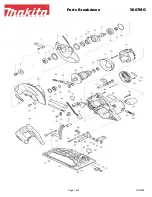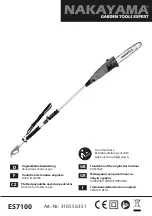
SM-S-9 XP Operator’s Manual
- 6 -
2017 Version 1.01
WARNING!
NEVER AIM THE BEAM AT A WORKPIECE WITH A REFLECTIVE SURFACE.
Highly
polished or similar reflective surfaces are not recommended for laser use where eye exposure is
possible due to reflection. These surfaces could reflect the beam back toward the operator or
bystanders.
ALWAYS CONSIDER THE PATH OF POSSIBLE BEAM DEFELCTION.
CAUSES AND PREVENTION OF KICKBACK
Kickback is a sudden reaction to a pinched, bound or misaligned saw blade, causing an
uncontrolled saw to lift up and out of the workpiece toward the operator. When the blade is pinched
or bound tightly by the kerf (saw cut) closing down, the blade stalls and the motor reaction drives
the unit rapidly back toward the operator. If the blade becomes twisted or misaligned in the cut,
the teeth at the back edge of the blade can dig into the top surface of the material causing the blade
to climb out of the kerf and the saw to jump back toward operator. Kickback is the result of tool
misuse and/or incorrect operating procedures or conditions and can be avoided by taking proper
precautions as given below:
Maintain a firm grip with both hands on the saw and position your body and arm to allow you to
resist KICKBACK forces. KICKBACK forces can be controlled by the operator, if proper
precautions are taken.
When blade is binding, or when interrupting a cut for any reason, release the trigger and hold the
saw motionless in the material until the blade comes to a complete stop. Never attempt to remove
the saw from the work or pull the saw backward while the blade is in motion or KICKBACK may
occur. Investigate and take corrective actions to eliminate the cause of blade binding.
When restarting a saw in the workpiece, center the saw blade in the kerf and check that saw teeth
are not engaged into the material. If saw blade is binding, it may walk up or KICKBACK from
the workpiece as the saw is restarted.
Support large panels to minimize the risk of blade pinching and KICKBACK. Large panels tend
to sag under their own weight. Supports must be placed under the panel on both sides, near the
line of cut and near the edge of the panel.
Never attempt to cut with a dull or damaged blade. Dull or improperly set blades produce a narrow
kerf which leads to excessive friction, blade binding and KICKBACK.
Blade depth and bevel adjusting locking levers must be tight and secure before making a cut. If
blade adjustment shifts while cutting, it may cause binding and KICKBACK.
Lower Guard Safety Instructions
•
Check lower guard for proper closing before each use. Do not operate the saw if lower guard
does not move freely and close instantly. Never clamp or tie the lower guard into the open










































